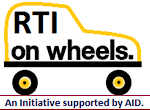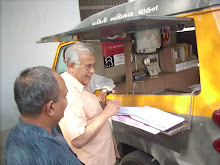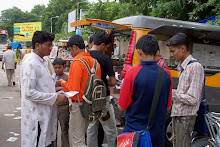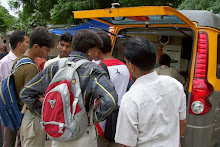The Indian Express: Pune: Thursday, August 03, 2017.
In the field
of civic activism, Pune has always shown the way. Activists have acknowledged
that the city’s spirit of activism has not only remained intact over the years,
but has also been strengthened by the RTI Act over a decade ago. Activists also
point out that the scope, variety and magnitude of the issues taken up by them
has expanded tremendously.
The Indian
Express led from the front
Over 20 years
ago, The Indian Express, under the banner of the Express Citizens Forum (ECF),
had, for the first time, raised the issue of pandals that were being
indiscriminately set up by Ganesh mandals on the congested and narrow roads of
the city. The large pandals occupied most roads, leaving little space for
vehicles.
The Indian
Express raised the issue with the PMC and police; urging them to discipline the
pandals and restore order. Its efforts received a vast amount of support from
activists and residents of Pune, forcing the authorities to take action. “After
that, activism in Pune took off in the right spirit,” recalled activist
Prashant Inamdar, who was associated with the ECF.
Soon, the
activists turned the heat on the state government, which had abruptly shunted
out Arun Bhatia, the then PMC commissioner in 1998. Activists believed that
Bhatia was transferred by a rattled state government as he was acting tough
against the corrupt and the wrong-doers.
Led by the
Express Citizens Front, they moved the Bombay High Court, which stayed Bhatia’s
transfer. “It was a major victory for activism in Pune,” said Inamdar.
In the
neighbouring Pimpri-Chinchwad, activist Maruti Bhapkar had to knock on the
doors of the High Court after the PCMC refused to get its accounts audited,
despite allegations of a Rs 250-crore scam. An irked high court then ordered
the audit of all past accounts of the civic body and sought to know from the
state government why the PCMC should not be dissolved. Since then, the PCMC has
consistently had its accounts audited.
In another
instance, activist Dominic Lobo had filed clippings of stories by The Indian
Express on the poor state of roads in Pimpri-Chinchwad in court. After perusal
of the clippings, the judge himself took a tour of Pimpri-Chinchwad and fined
the then PCMC commissioner, asking him to repair the roads quickly. The civic
chief appealed in a higher court, which not only upheld the fine but increased
it.
“The case set
a precedent. It was a case of activists with meagre resources fighting against
the system … it was activism that won the day,” said Lobo.
RTI
changed the game
THE Right to
Information Act, 2005, has been a game-changer, said activists. “Before the Act
came into force, journalists had to virtually extract all possible information
from officials, who often managed to hide explosive information. But the RTI
Act has changed all that. They can no longer hide vital information… RTI has
made… activism more meaningful and powerful, facilitating better planning and
strategising,” said both Inamdar and Lobo.
The tools of
activism have also changed from holding protests to the use of Lokshahi Din,
as well as filing PILs and RTI applications to expose wrong-doings. “Anybody
can participate in activism now… an individual can make the system change…,”
said activist Vivek Velankar.
And armed
with tools like RTI, Puneites have realised that they no longer need to reach
out to political parties or corporators to get their work done or force the
authorities to act. “In the past, activism was sort of a full-time job… now,
the availability of information tools has made things easier,” said Velenkar.
Civic
activist Satish Khot said, “Several activists are now using this tool to seek
information related to various civic issues and expose the functioning of the
civic departments”.
Another
activist, Vijay Kumbhar, adds, “Before RTI came into effect, activists had to
file public interest litigations, which was time-consuming. But RTI become a
powerful weapon to dig out key information from officialdom.”
Other
helpful tools
Civic
activists point out that various websites also provide information about a host
of issues, as well as names and contact details of ministers, officers etc.
“This makes it easy to take up issues via e-mails, marking copies to all
concerned… Print and visual media have also become very active in encouraging
activists, both individuals and groups, to take up matters… WhatsApp and email
groups have facilitated sharing of information and activities among people
working in the same field. Networking and synergy have improved vastly,” said
Inamdar.
Individual
activism
Satish Khot,
the former president of National Society for Clean Cities, says, “Twenty years
ago, local residents expected someone else to come forward to solve their
problems. Although they were willing to sit and talk about issues, people
didn’t want to be seen asking questions. Today, they have become more aware and
are getting involved in civic issues.”
Meanwhile,
Velankar said the city will never shed its identity of being a hub of activism.
“Activism has changed from collective activism to individual activism, but the
impact continues to be the same,” he said.
Activists
with a cause, or many causes
Vijay Kumbhar
caused tremors in civic corridors after he raised the issue of favours given to
Girish Vyas, son-in-law of then chief minister Manohar Joshi, for allowing him
to build on a land reserved for a primary school in the development plan of the
city. The controversy had forced Joshi to step down from his post. “This was
one of those cases which attracted nationwide attention… but there have been
cases taken up by activists, including me, which forced the authorities to
frame new policies,” he added.
There are
many other activists working in specific fields.
Recently,
activist Sarang Yadwadkar, along with a few others, made the PMC stop the
construction of a road alongside Mutha river. The case was taken to the
National Green Tribunal; the civic body had to put an end to encroachments on
Mutha river, and demolish the half-done work of road construction and remove
the debris.
Aneeta
Gokhale Benninger has been fighting to protect the green cover of the city
through the Green Pune Movement. Sujit Patwardhan, through Parisar, has taken
up various civic issues pertaining to the city and is focussed on road safety
and sustainable urban transport. He and Ranjit Gadgil also work on promotion of
non-motorised transport.
The Nagrik
Chetana Manch, under its chief Major General S C N Jatar (retired), continues
to take up by the extensive use of RTI and challenging the decisions of the
civic body in various courts.
Qaneez
Sukhrani, who is associated with several organisations, has also taken up
several civic and transport issues, including the pathetic state of BRTS
routes. Prashant Inamdar, who heads Pedestrians First, has taken up the
condition of roads, footpaths, flyovers, subways, speed-breakers and dividers
in the city.
Jugal Rathi,
who heads PMP Pravasi Manch, has been fighting to ensure better PMPML services
for 12 lakh commuters. Harsha Shah, of the Railway Pravasi Group, takes up the
woes of railway commuters.














































































